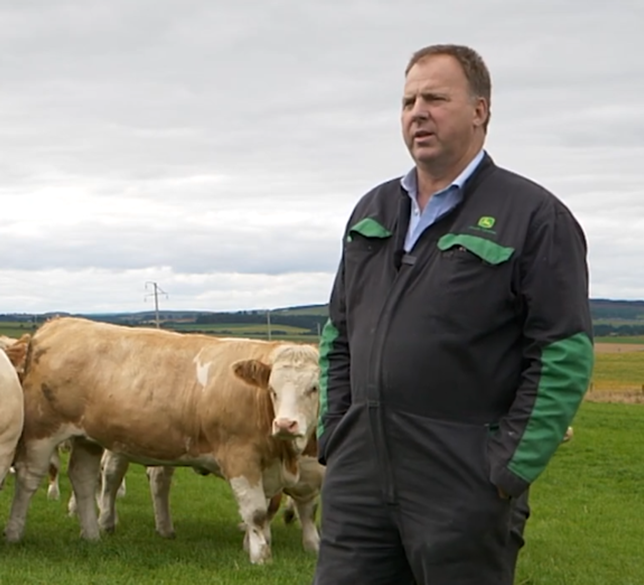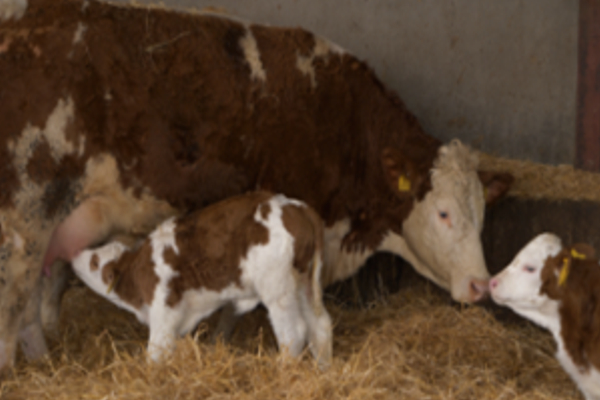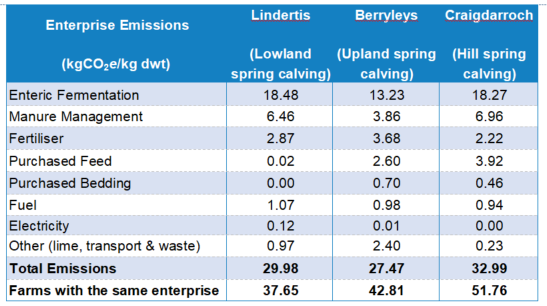Calving Heifers at 2.5 Case Study
3 April 2023Stewart Stronach, Berryleys
Stewart Stronach farms at Berryleys, a 303 ha (750 acre) mixed livestock and arable farming business on the outskirts of Keith, Banffshire in partnership with his parents Stewart Snr and Hazel, partner Fiona, and son Michael. All the land farmed lies between 100—190 m above sea level.
Berryleys is home to the 200 head of mainly pedigree Simmental cows of the Islavale herd, which is split 50:50 between spring and autumn calving. This allows heifers born into the spring herd to calve into the autumn herd and vice versa at 2.5 years old.
With the exception of replacement heifers and bulls for breeding, all progeny is intensively finished on farm.
In addition, the business runs 300 crossbred ewes with lambs sold finished via local auction marts. Most of the land is in grass for grazing and producing silage, but approximately 200 acres (80 ha) is used for growing spring barley destined for the local maltings and distilleries.

Heifer Selection and Management
Around 30 heifers are retained as replacements each year and selected based on their pedigree and mother’s ability. Due to the split calving herd, there is a plentiful supply of heifers available. Following weaning, heifers identified as replacements are maintained on a commercial store ration and receive a trace element bolus before turn-out.
Heifers are on an AI programme developed by the AI technician following synchronisation and double AI 24 hours apart in the first week of June. Conception rates to this protocol are usually 70—72% and a bull is put in with the heifers 12 days after AI for an 8 week period to sweep up any that return to service. The bull used for AI is homebred with easy calving EBVs and has been proven over the years to be a good bull for use on heifers. During the bulling period, no supplementary feeding is provided.
In 2022 the bull was removed on 8th August and heifers were pregnancy scanned on 30th September. The rate confirmed in calf was lower than normal with four of the batch empty, giving a conception rate of 80%. Blood testing for infectious diseases and trace elements did not identify any problems and there was no sign of abnormalities on internal examination.
Heifers are kept outside as long as ground conditions permit before being housed in straw-bedded courts over winter. Apart from worming at housing, no treatments are administered to the heifers pre-calving. They are fed a silage and straw ration with a pre-calving mineral to lose some condition over the winter before calving. The 2022 crop of silage analysed at 32% DM, 11.8 MJ ME/kg and 11% CP.
Calving Management

Calving was due to start on 16th March, but was delayed by a few days. By 24th March only four heifers had calved and all had been twins. Unfortunately, the first set of twins was still born and a further twin was stillborn from another set. However, all heifers are running with a single calf. Due to the high level of twins in the herd (up to 20% in some years), there is always a spare calf to twin on if one is lost. The mothering ability of the heifers is excellent, with a plentiful supply of milk.
Calves receive a vitamin E and selenium injection and have their navels dipped in iodine at birth. They are then tagged and have dehorning paste applied at around 4 days old, before being turned out if the weather and ground conditions are favourable.
Following calving, the heifers are integrated into the cow herd for their second bulling and do not receive any supplementary feeding. Any heifers requiring assistance at calving are usually given a second chance and can move into the other herd to allow them a further six months to get in calf.
Impact of Calving at 2.5 on the Farm's Carbon Footprint

The carbon footprint for the beef enterprise for the year ending September 2022 was 27.47 kg CO2e/kg dwt, which was 35.8% lower than average spring calving upland herds and in line with the top 25% of producers. The biggest contributor to the carbon footprint was enteric fermentation, but this is still 40.9% lower than average due to the bull beef system operated for young stock. Young bulls are sold at 750 kg liveweight at 13 months old, while heifers are finished at the same weight at 17 months old. This also accounts for the increased level of purchased feed compared to average, but is supported by the higher daily liveweight gain figure of 1.53 kg/day versus 0.95 kg/day on average.
The cows at Berryleys are fed a forage-based ration of silage and straw during the winter and grazing grass and forage crops during the summer and autumn. Consequently, fertiliser use is higher than the top 25% to maintain good yields. However, much of this fertiliser is organic in the form of cattle FYM and anaerobic digestate. Berryleys also apply a lot of lime to grazing land to maintain soil pH for good grass growth which has led to the ‘other’ figure (includes crop residues, lime, transport and waste) being 110.5% higher than average.
Fertility within the Berryleys herd is excellent compared to the average of 92%, with an overall calving percentage of 106% due to the high level of twinning.
Comparing the Focus Farmers Calving at 2, 2.5 and 3
To compare the impact of calving heifers at 2, 2.5 and 3 years old, Lindertis, Berryleys, and Craigdarroch each completed a carbon audit for the year ending September 2022 using SAC's farm calculator tool, Agrecalc. The enterprise emission and technical performance comparison data is shown in the tables below.


All three farms have carbon footprints for their beef enterprises well below the comparative average for the systems they run. This is largely due to their excellent fertility and low mortality. The variation between the level of output from the three farms reflects the different systems they run, with Craigdarroch operating an extensive, low-input herd, whereas Berryleys operates an intensive bull-beef finishing and forage-based suckler herd, with Lindertis sitting between these.
This is also mirrored in the daily live weight gains of the three farms. Mature cow size influences feed use too, with the large Simmentals at Berryleys requiring more feeding than the smaller Luings at Craigdarroch. Overall there is little difference in the carbon footprint of farms calving heifers at 2, 2.5, or 3 years old, as all three farms studied utilise their resources efficiently.
In summary, choosing the right age at first calving is highly dependant on the system operated and ultimately good management (nutrition, heifer selection, BCS and genetics) is key to ensuring heifers reach growth targets and successfully rebreed. For more information on this ‘Choosing the right age to calve heifers’ series visit the FAS webpage —www.fas.scot/livestock/calving-heifers-vlog-series.
Author—Laura Henderson, SAC Consulting
March 2023
Sign up to the FAS newsletter
Receive updates on news, events and publications from Scotland’s Farm Advisory Service
